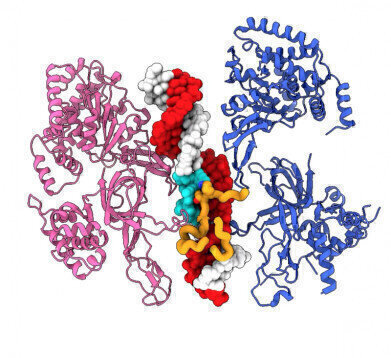-
 The yeast replicative helicase captured as it opens the DNA double helix (credit: The Francis Crick Institute)
The yeast replicative helicase captured as it opens the DNA double helix (credit: The Francis Crick Institute)
News
Crick Researchers make key DNA discovery
Jun 23 2022
A collaborative study by researchers at the Francis Crick Institute has uncovered how the double helix structure of DNA is opened to allow DNA replication, essential for enabling processes including DNA repair, gene expression and replication of DNA for cell division to occur. This discovery opens pathways for further investigation into cellular processes including how diseases such as cancer could be initiated.
Using the advanced imaging capability of cryo-electron microscopy scientists with the Crick’s Chromosome Replication Laboratory, the Macromolecular Machines Laboratory and the Structural Biology Science Technology Platform used a yeast model to visualise the full process of the DNA double helix being untwisted and opened.
The team observed that, after embracing the DNA, two enzymes drift away from each other in a process that deforms the double helix, initiating the process of DNA opening.
Alessandro Costa, author and group leader of the Macromolecular Machines Laboratory said: “Over decades, scientists, including our collaborator John Diffley, in at the Crick, have pieced together which enzymes are required to open DNA and initiate replication.
“We now looked at replication initiation under the microscope and discovered that the mechanism is completely different from the way the DNA double helix is opened to start other cellular processes, such as gene transcription and recombination. We hope that understanding this difference will allow us and other research groups to build a detailed picture that captures the complexities of life.”
Jacob Lewis, author and Postdoctoral Training Fellow in the Macromolecular Machines Laboratory commented: “Understanding the mechanism for the melting of the DNA double helix provides the basis to study how initiation of DNA replication is controlled. This has important implications for understanding the maintenance of chromosome integrity, a process which goes wrong in cancer.”
The scientists will continue this work, to understand how the DNA replication machinery unzips the double helix after opening and how this is regulated to avoid accumulation of DNA damage.
Published in Nature (June 15)
More information online
Digital Edition
Lab Asia Dec 2025
December 2025
Chromatography Articles- Cutting-edge sample preparation tools help laboratories to stay ahead of the curveMass Spectrometry & Spectroscopy Articles- Unlocking the complexity of metabolomics: Pushi...
View all digital editions
Events
Jan 21 2026 Tokyo, Japan
Jan 28 2026 Tokyo, Japan
Jan 29 2026 New Delhi, India
Feb 07 2026 Boston, MA, USA
Asia Pharma Expo/Asia Lab Expo
Feb 12 2026 Dhaka, Bangladesh


















